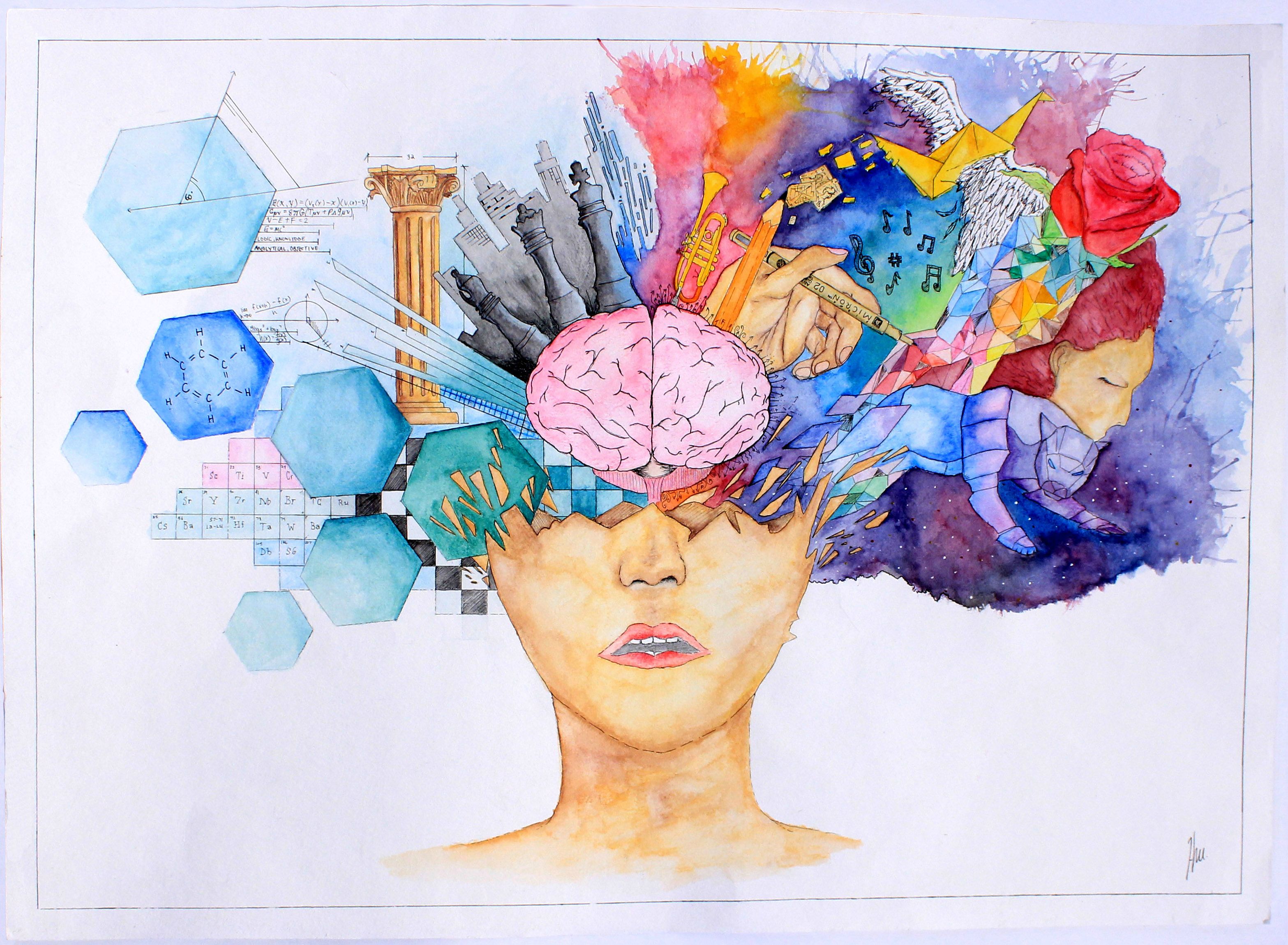This article is an overview of a study conducted at the Nova University Biofeedback Lab, resulting in not only a new approach to stress reduction, but also an innovative method to "exercise" our right brain hemispheres so as to promote its rightful and equal dominance with the left. Doing so would result in an increase in creativity, mindfulness, and a higher degree of empathy towards others and the earth. In short, increased right-brain holistic thinking would improve our world-view to be more inclusive of both our bio-sphere and our human-sphere, and to reconnect us with our essential creative and loving spiritual selves.
Reducing Stress and Increasing Creativity
I draw on an experiment that was conducted at Nova University’s Behavioral Science Center in 1978. The principle investigator was Joyce Keen who conducted this study as part of her doctoral dissertation. This is an overview of that study.
Overview
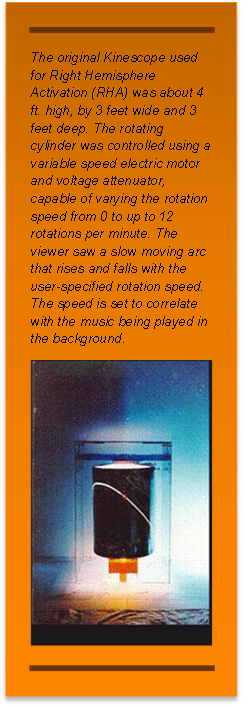 The biofeedback study Hemispheric and Autonomic Laterality: Effects of Unilateral Repetitive Activation 1 was conducted at the Nova University Biofeedback Laboratories, under the guidance of noted biofeedback pioneer Dr. Joe Kamiya. The study involved 47 volunteer subjects, split between the experimental group watching a visual device, called the “Kinoscope”, (see picture and description below) and a control group.
The biofeedback study Hemispheric and Autonomic Laterality: Effects of Unilateral Repetitive Activation 1 was conducted at the Nova University Biofeedback Laboratories, under the guidance of noted biofeedback pioneer Dr. Joe Kamiya. The study involved 47 volunteer subjects, split between the experimental group watching a visual device, called the “Kinoscope”, (see picture and description below) and a control group.
The experimental group is referred to as the Right Hemisphere Activation (RHA) group. This group, in addition to watching the Kinescope, also listened to meditative music. The control group, also referred to as the Left Hemisphere Activation (LHA) group, listened to spoken text while also seeing the text projected onto a screen. Several biofeedback measures were recorded one each subject during the sessions:
- Bilateral skin conductance level (SCL)
- Heart rate (HR)
Specifically, three hypotheses were tested:
- Individuals whose right hemispheres are being activated by the processing of repetitive spatial information should demonstrate shorter recovery following induced arousal than individuals whose left hemispheres are being activated by repetitive verbal information;
- Individuals whose left hemispheres have been repeatedly activated should score higher on post treatment verbal tasks
- Individuals whose right hemispheres have been repeatedly activated should score higher on post-treatment spatial tasks.
Each subject came to the laboratory three times a week for two weeks for a total of six sessions. SCL and HR were monitored for the entire 45 minutes of each session with time samples recorded every minute for each variable. The first 15 minutes of each session was a stabilization period. During sessions two, four, and six, three disruptions were randomly presented to elicit a startle response, allowing at least five minutes for recovery from each of nine disruptions. Visual startle consisted of turning on an overhead light; auditory startle was elicited by hitting a metal file cabinet with a hammer; and touch startle consisted of two taps on the right forearm by the experimenter. Time for recovery to baseline was noted in seconds.
Results: The RHA Group Learned to Handle Stress Much More Effectively than
the LHA Group
The resulting data was analyzed using various statistical techniques, and proved conclusive: the subjects watching the Kinescope (the right hemisphere activation group) recovered from startle significantly faster than those in the control group. In other words, after exposure to the Kinescope, the subjects in the RHA group were able to “relax” significantly more quickly than the LHA group.
The RHA group recovered significantly faster from startle than the left hemisphere activation (LHA) group, F (3, 43) = 20.80, p<.001 as determined by a MRM analysis (see Figures 1 and 2).
|
GROUP |
|
LEFT SKIN CONUCTANCE |
RIGHT SKIN CONDUCTANCE |
HEART BEAT |
|
|
|
LSCLR |
RSCLR |
HBR |
|
RHA |
Mean |
70.5 |
82.6 |
55.8 |
|
(N = 24) |
SD |
82.5 |
84.5 |
31.5 |
|
LHA |
Mean |
166.5 |
163.6 |
91.9 |
|
(N = 23) |
SD |
75.4 |
75.5 |
37.3 |
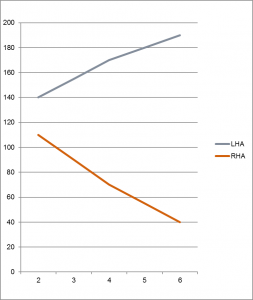
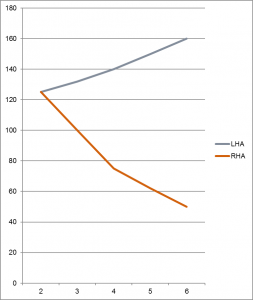
Applications
The practical applications of this finding alone are fairly intuitive as many current diseases are considered to be stress related. The following list of stress related illnesses is taken from an article by By R. Morgan Griffin as a WebMD Feature, and was reviewed by Joseph Goldberg, MD:
- Heart disease. Researchers have long suspected that the stressed-out, type A personality has a higher risk of high blood pressure and heart problems. We don’t know why, exactly. Stress can directly increase heart rate and blood flow, and causes the release of cholesterol and triglycerides into the blood stream. It’s also possible that stress is related to other problems — an increased likelihood of smoking or obesity — that indirectly increase the heart risks.Doctors do know that sudden emotional stress can be a trigger for serious cardiac problems, including heart attacks. People who have chronic heart problems need to avoid acute stress — and learn how to successfully manage life’s unavoidable stresses — as much as they can.
- Asthma. Many studies have shown that stress can worsen asthma. Some evidence suggests that a parent’s chronic stress might even increase the risk of developing asthma in their children. One study looked at how parental stress affected the asthma rates of young children who were also exposed to air pollution or whose mothers smoked during pregnancy. The kids with stressed out parents had a substantially higher risk of developing asthma.
- Obesity. Excess fat in the belly seems to pose greater health risks than fat on the legs or hips — and unfortunately, that’s just where people with high stress seem to store it. “Stress causes higher levels of the hormone cortisol,” says Winner, “and that seems to increase the amount of fat that’s deposited in the abdomen.”
- Diabetes. Stress can worsen diabetes in two ways. First, it increases the likelihood of bad behaviors, such as unhealthy eating and excessive drinking. Second, stress seems to raise the glucose levels of people with type 2 diabetes directly.
- Headaches. Stress is considered one of the most common triggers for headaches — not just tension headaches, but migraines as well.
- Depression and anxiety. It’s probably no surprise that chronic stress is connected with higher rates of depression and anxiety. One survey of recent studies found that people who had stress related to their jobs — like demanding work with few rewards — had an 80% higher risk of developing depression within a few years than people with lower stress.
- Gastrointestinal problems. Here’s one thing that stress doesn’t do — it doesn’t cause ulcers. However, it can make them worse. Stress is also a common factor in many other GI conditions, such as chronic heartburn (or gastroesophageal reflux disease, GERD) and irritable bowel syndrome (IBS), Winner says.
- Alzheimer’s disease. One animal study found that stress might worsen Alzheimer’s disease, causing its brain lesions to form more quickly. Some researchers speculate that reducing stress has the potential to slow down the progression of the disease.
- Accelerated aging. There’s actually evidence that stress can affect how you age. One study compared the DNA of mothers who were under high stress — they were caring for a chronically ill child — with women who were not. Researchers found that a particular region of the chromosomes showed the effects of accelerated aging. Stress seemed to accelerate aging about 9 to 17 additional years.
- Premature death. A study looked at the health effects of stress by studying elderly caregivers looking after their spouses — people who are naturally under a great deal of stress. It found that caregivers had a 63% higher rate of death than people their age who were not caregivers.
Can We Learn to be More Creative?
Creativity is typically considered an attribute of the right brain hemisphere. Since the research cited strongly suggests an association between the activities of the the experimental group and right hemisphere activation, this begs the question, “Can we learn to be more creative?”
Creativity as measured by the Torrance Tests of Creative Thinking increased until 1990 in the United States. Thereafter scores have been declining. Kyung Hee Kim at the College of William & Mary discovered this in May, after analyzing almost 300,000 Torrance scores of children and adults. Kim found creativity scores had been steadily rising, just like IQ scores, until 1990. Since then, creativity scores have consistently
inched downward. “It’s very clear, and the decrease is very significant,” Kim says. It is the scores of younger children in America—from kindergarten through sixth grade—for whom the decline is “most serious.”
Renowned psychiatrist and writer Iain McGilchrist suggests that civilization, up to around the 16th century, maintained a reasonable balance between the left/right worlds. However, that balance has since slowly shifted towards the left hemisphere, leaving us with a modern-day sterile world devoid of interconnectedness, empathy, and a sense of “life”.
Could it be that this increasing emphasis on left-brain thinking has caused a decrease in our ability to be creative?
Henk J. Haarman’s research at the University of Maryland Center for Advanced Study of Language investigates the link between divergent thinking and the brain’s alpha waves. He has found that students who showed higher alpha activity in between solution attempts were more successful at problem solving.
“This wave type has been used as a universal sign of relaxation during meditation and other types of rest,”
comments Professor Øyvind Ellingsen, who studies the effect of alpha waves at the Norwegian University of Science and Technology. “The amount of alpha waves increases when the brain relaxes from intentional, goal-oriented tasks. This is a sign of deep relaxation, — but it does not mean that the mind is void. This default activity of the brain is often underestimated. It probably represents a kind of mental processing that connects various experiences and emotional residues, puts them into perspective.”
Brainwave researcher Kelly Howell suggests that: “Relaxation enables us to go inward, to allow our unconscious minds to uncover creative solutions our conscious minds might not recognize. Dreams have inspired Einstein and Physicist Nils Bohr, Coleridge’s poem Kubla Khan, and others including Paul McCartney, Edgar Allen Poe, Robert Louis Stevenson and Steven King.”
Text Box: Figure 3: Mental state in terms of challenge level and skill level, according to Csikszentmihalyi’s flow model.
In a recent large review, Rex Jung and colleagues provide a “first approximation” regarding how creative cognition might map on to the human brain. Their review suggests that when you want to loosen your associations, allow your mind to roam free, imagine new possibilities, and silence the inner critic, it’s
good to reduce activation of the Executive Attention Network (a bit, but not completely) and increase activation of the Imagination and Salience Networks. Indeed, recent research on jazz musicians and rappers engaging in creative improvisation suggests that’s precisely what is happening in the brain while in a flow state.
Unfortunately the study Hemispheric and Autonomic Laterality: Effects of Unilateral Repetitive Activation didn’t measure brain wave activity during the experiment. However, we suspect that the RHA group would have exhibited an increase in alpha wave (characteristic of wakeful rest) activity. We do know, at the very least, that the RHA group exhibited a statistically validated “relaxation response” which seems to be an important part of the overall creative process.
Can We Learn to be More Empathetic?
Empathy is typically considered an attribute of the right brain hemisphere. Since the research cited strongly suggests an association between the activities of the the experimental group and right hemisphere activation, this begs the question, “Can we learn to be more empathetic?”
Few would disagree that the human race could stand a huge boost in its ability to empathize. Renowned
psychiatrist and writer Iain McGilchrist states that “the right hemisphere yields a world of individual, changing, evolving, interconnected, implicit, incarnate, living beings in the context of the lived world”, and characterizes the left hemisphere as lifeless, static, fixed and isolated. With more empathy, we could well see a reduction in wars, a reduction in civil rights violations, more awareness of our earth’s environment, more humanitarian aid to those in need, and less economic inequality.
Recent research conducted at Emory University and subsequently published in the journal Social Cognitive and Affective Neuroscience, showed that a meditation program called Cognitively-Based Compassion Training was able to improve people’s ability to read emotional expressions on others’ faces.
So, perhaps empathy can in fact be “activated”?
The idea of “activating” empathy through right brain stimulation was beyond the scope of the study I have been referencing. But perhaps it isn’t too much of a stretch to suggest that by “exercising” the right brain, as we did with the RHA group, attributes of the right brain hemisphere can in fact be enhanced and/or strengthened.
About the Author:
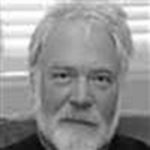 James Wilson is a senior generalist, design consultant, researcher, blogger, activist, BMI composer and performing artist. B. of Music from Boston University, School of Fine and Applied Arts. 3/4 of a Masters in Music Composition from Temple University (program not 100% completed due to mitigating circumstances).
James Wilson is a senior generalist, design consultant, researcher, blogger, activist, BMI composer and performing artist. B. of Music from Boston University, School of Fine and Applied Arts. 3/4 of a Masters in Music Composition from Temple University (program not 100% completed due to mitigating circumstances).
I was involved with the experiment at Nova U. in several ways. I am the inventor of
the visual device used for the RHA group, then called a ‘Kinescope’. As the inventor, I was heavily involved in the Kinescope’s setup and use. I am also handy with computers, and so helped Joyce Keen process the mountain of data collected during the study.”
The majority of the original compositions located at the One Mind Media Music site, are composed/played by JR Wilson.
The majority of the the multi-media on the OMM YouTube site, are visual compilations and musical compositions by JR Wilson.
Further information can be obtained by emailing the author at: jimdubyah@gmail.com

1 Nova Southeastern University, Library Research and Information Technology Center. Broward County, Florida, USA. Author Keen, Joyce. Title: Hemispheric and Autonomic Laterality: Effects of Unilateral Activation / by Joyce Keen. Publisher [S.l. : s.n.] 1978. NOTE: The full study referenced here can be accessed HERE.
Keywords: Dance Therapy, Music Therapy, Pain Management, Stress Reduction, Creativity Enhancement, Education, Language, Conceptual Skills, Mindfulness, Emotional Literacy, Emotional Intelligence, Flow
State, Mihaly Csikszentmihalyi, Creativity, Empathy, Left Brain, Right Brain, Cognition, flow machine, time machine
